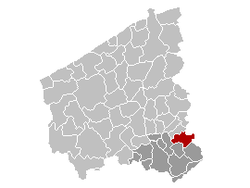Waregem
| Waregem | ||
|---|---|---|
| Municipality | ||

Waregem city hall
|
||
|
||
| Location in Belgium | ||
| Coordinates: 50°53′N 03°25′E / 50.883°N 3.417°ECoordinates: 50°53′N 03°25′E / 50.883°N 3.417°E | ||
| Country | Belgium | |
| Community | Flemish Community | |
| Region | Flemish Region | |
| Province | West Flanders | |
| Arrondissement | Kortrijk | |
| Government | ||
| • Mayor | Kurt Vanryckeghem | |
| • Governing party/ies | CD&V | |
| Area | ||
| • Total | 44.34 km2 (17.12 sq mi) | |
| Population (1 January 2016) | ||
| • Total | 37,606 | |
| • Density | 850/km2 (2,200/sq mi) | |
| Postal codes | 8790-8793 | |
| Area codes | 056 | |
| Website | www.waregem.be | |
Waregem (Dutch pronunciation: [ˈʋaːrəɣɛm]) is a municipality located in the Belgian province of West Flanders. The municipality lies in the valley of the Leie River, between Kortrijk and Ghent. It is part of the arrondissement of Kortrijk and comprises the towns of Beveren, Desselgem, Sint-Eloois-Vijve and Waregem proper. On January 1, 2006, Waregem had a total population of 35,852. The total area is 44.34 km² which gives a population density of 809 inhabitants per km².
The first inhabitants of this forested region settled along the Leie River well before Roman times. Bronze coins and artifacts associated with the Gallo-Roman culture show extensive activity in this area in the first centuries of our era. This is not surprising given the fact that Sint-Eloois-Vijve stood at the intersection of two important Roman roads: Cassel-Tongeren and Bavai-Oudenburg. The name of the current municipality refers to a certain “Waro” clan or tribe, possibly dating from the Frankish period.
In the 10th century, most of Waregem’s territory was given as a grant to the St Peter Abbey in Ghent. The local administrative center used by the Benedictines along the Leie River can still be seen today and is still known as the Munkenhof. At the end of the century, Baldwin IV, Count of Flanders, made this area the base from which he could advance against Kortrijk. During the following centuries, the medieval feudal system allowed the land to be progressively parceled out to landowners from places as far as Dendermonde and Tournai. At that time, like in the rest of Flanders, most of the population consisted of farmers, spinners and weavers. Tax documents from the 13th century attest to the strong economic activity of the time. Waregem’s attempt in 1635 at obtaining rights to hold its own market was opposed by the neighbouring towns. A Saturday market was finally approved by Joseph II of Austria in 1784.
...
Wikipedia



